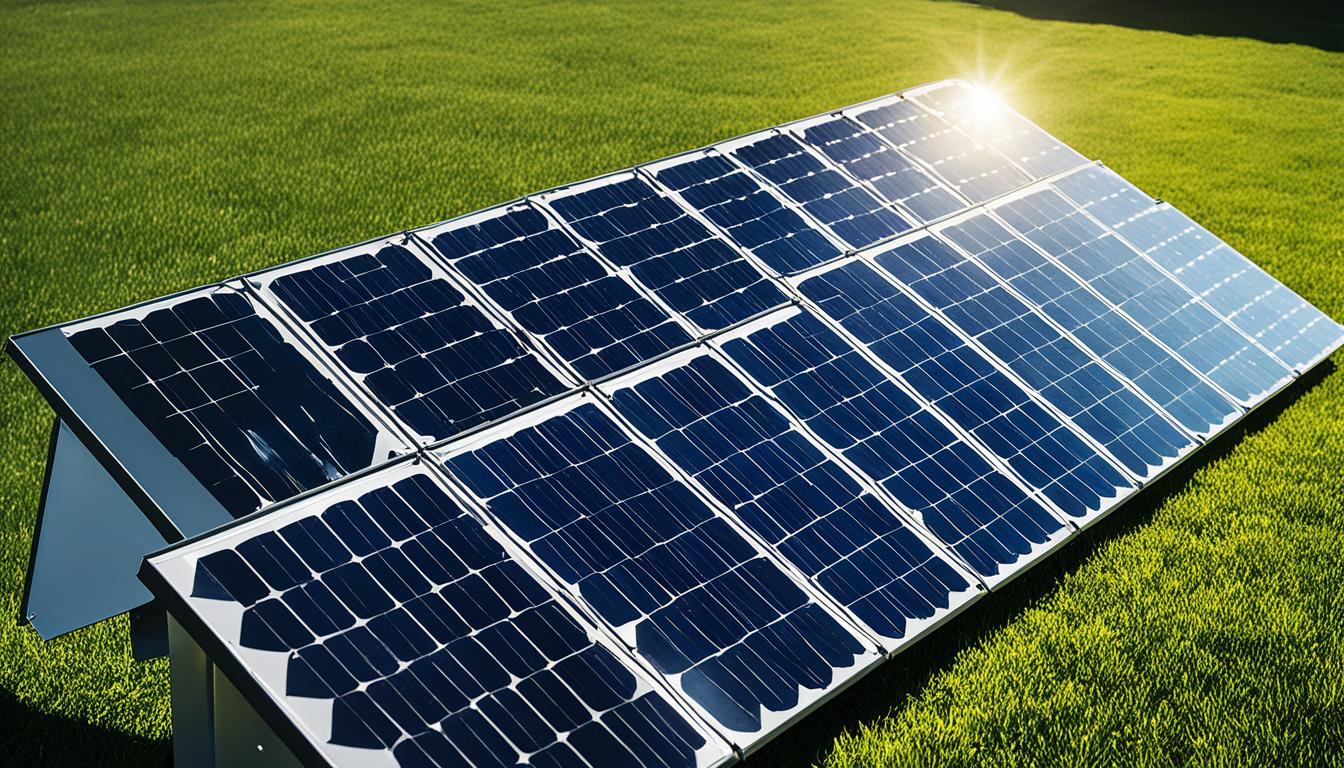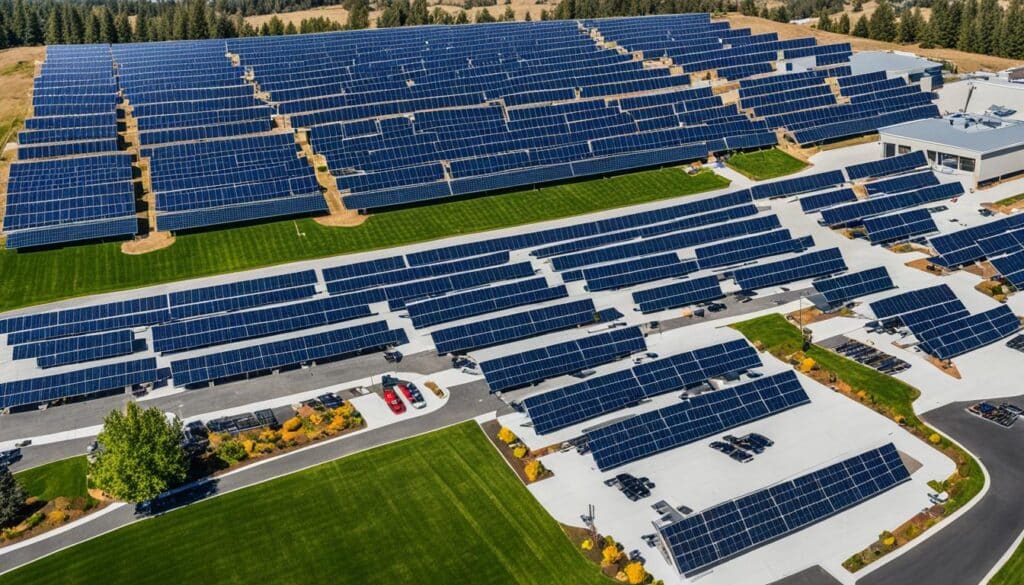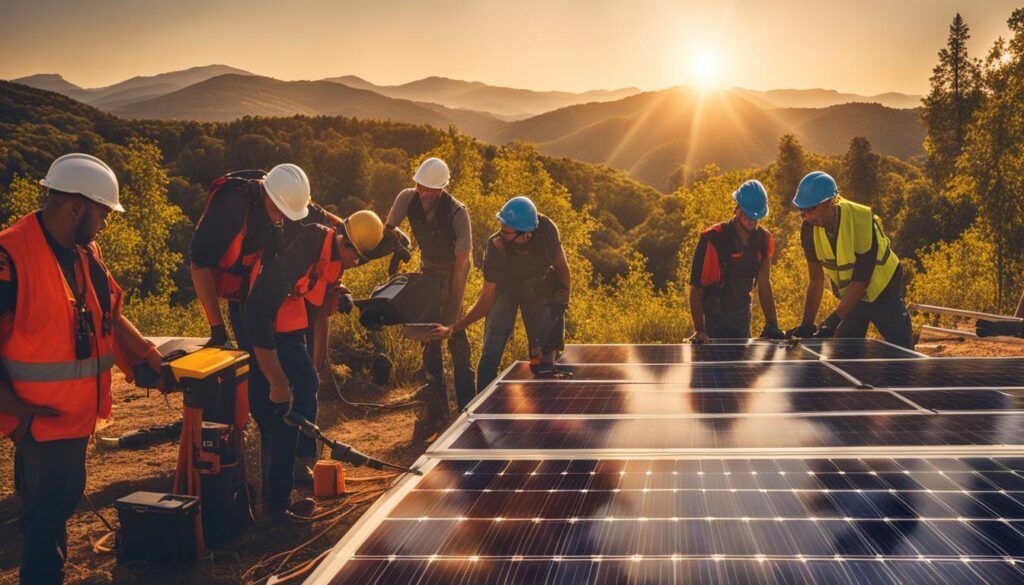
When it comes to community solar projects, achieving maximum efficiency and optimal placement of solar panels is paramount. Not only does it improve the overall performance of the project, but it also contributes to sustainability and the long-term success of renewable energy initiatives. In this article, I will provide you with essential tips to help you maximize solar panel efficiency and strategically plan their placement for your community solar project.
Key Takeaways:
- Proper placement, orientation, and regular maintenance are crucial for maximizing solar panel efficiency.
- Consider factors such as sunlight exposure, tilt, angle, and cleaning to enhance efficiency.
- Using high-quality solar panels and optimizing system design can further improve efficiency.
- Optimal solar panel placement requires evaluating available space, shading, and local regulations.
- Engaging the community and collaborating with local stakeholders are essential for sustainable solar energy initiatives.
Understanding the Importance of Salmon and Sustainable Energy
Salmon are a vital component of California’s ecosystem, playing a crucial role in maintaining the balance of rivers and supporting various fisheries. They also hold immense cultural significance for indigenous tribes, with their presence woven into the fabric of creation stories and tribal traditions. Protecting and preserving salmon populations is therefore essential for the overall health and sustainability of the ecosystem.
At the same time, the need for sustainable energy sources has become increasingly pressing in recent years. With environmental goals at the forefront of global initiatives, it is imperative to harness clean and renewable energy to minimize the impact on our planet. This is where the connection between salmon and sustainable energy comes into play.
Community solar projects offer a viable solution by combining the benefits of solar power with the goal of protecting salmon populations. By maximizing solar panel efficiency and strategic placement, these projects contribute to sustainable energy production while mitigating the impact on the environment. The abundant energy harnessed from the sun helps reduce reliance on fossil fuels and decreases greenhouse gas emissions, aligning with the larger environmental goals of promoting a cleaner and greener future.
The Role of Solar Energy in supporting the Ecosystem
Solar energy provides a way to generate electricity without depleting finite resources or releasing harmful pollutants into the atmosphere. By utilizing this clean and renewable energy source, community solar projects can help meet the energy demands of communities while minimizing their ecological footprint.
- Solar power reduces the need for traditional energy sources such as coal or natural gas, leading to a decrease in air and water pollution.
- By utilizing solar energy, we can avoid the detrimental impacts on ecosystems and biodiversity caused by conventional energy generation methods.
- Community solar projects can help address the environmental challenges we face today by promoting sustainable energy practices and reducing our reliance on non-renewable resources.
Sustainable energy production is crucial for achieving a harmonious balance between human activities and the natural world. By embracing solar power and protecting the habitats of vital species like salmon, we can work towards a more sustainable and resilient future.
Visualizing the Impact: Solar Efficiency and Salmon Conservation
Let’s take a moment to visually understand the importance of solar efficiency and its impact on salmon conservation. The table below highlights the environmental benefits of maximizing solar panel efficiency:
| Benefits of Maximizing Solar Panel Efficiency | Impact on Salmon Conservation |
|---|---|
| Reduced reliance on non-renewable energy sources | Minimizes the environmental disturbance caused by energy extraction and reduces the risk of habitat degradation for salmon. |
| Decreased greenhouse gas emissions | Reduces the negative impacts of climate change that can affect salmon migration patterns, spawning success, and overall population health. |
| Increased energy independence | Supports efforts to create a sustainable energy infrastructure, reducing the need for energy imports and potential disruptions to salmon habitats due to resource extraction. |
By prioritizing solar panel efficiency and considering the role of sustainable energy in salmon conservation, community solar projects can play a vital role in achieving environmental goals and fostering a healthier ecosystem.
Tips for Maximizing Solar Panel Efficiency
When it comes to maximizing solar panel efficiency, there are several key factors to consider. Proper placement, orientation, and maintenance play a crucial role in enhancing the performance and overall effectiveness of solar panel systems. By following these tips, you can optimize your solar panels to generate more clean and sustainable energy while minimizing wasted resources.
1. Placement for Maximum Sunlight Exposure
The placement of solar panels is critical for maximizing sunlight exposure and, consequently, energy production. Ideally, panels should be installed in locations where they receive the most direct sunlight throughout the day. This often means avoiding shading from trees, buildings, or other obstructions that can inhibit sunlight from reaching the panels. Additionally, orienting the panels towards the sun’s path based on your geographical location can further enhance their efficiency.
2. Consider Tilt and Angle
The tilt and angle of solar panels have a significant impact on their efficiency. The optimal tilt angle depends on your latitude, with different angles recommended for regions closer to the equator compared to those further north or south. The angle should be adjusted to ensure maximum exposure to the sun’s rays, especially during peak sunlight hours. Manufacturers and solar professionals can provide guidance on the ideal tilt angle for your specific location.
3. Regular Cleaning and Monitoring
Accumulated dirt, debris, or even bird droppings can reduce the efficiency of solar panels by blocking sunlight from reaching the photovoltaic cells. Therefore, it is essential to clean the panels regularly to maintain optimum performance. A mild detergent and water solution, along with a soft brush or cloth, can effectively remove dirt without damaging the panels. Additionally, monitoring your solar panel system’s performance regularly can help detect any issues or malfunctions that may hinder efficiency.
4. Use High-Quality Solar Panels
Investing in high-quality solar panels can significantly improve efficiency and overall performance. Premium panels often incorporate advanced technologies, such as monocrystalline or polycrystalline silicon, proven to have higher conversion rates and increased durability. While these panels may come at a higher initial cost, the long-term benefits in terms of energy production and lifespan justify the investment.
5. Optimize System Design
Efficient system design involves evaluating various components, such as the inverter, wiring, and balance of system (BOS), to ensure they complement the solar panels’ performance. Consulting with experienced solar professionals can help design an optimized system that minimizes energy losses, maximizes output, and ensures the overall efficiency of the solar panel installation.
By implementing these tips for maximizing solar panel efficiency, you can enhance the performance of your solar energy system and maximize the clean and sustainable energy it produces. Whether you are a homeowner, business owner, or part of a community solar project, optimizing solar panel efficiency is crucial for creating a greener future.
Optimizing Solar Panel Placement for Community Solar Projects
When planning solar panel placement for community solar projects, it is essential to consider several factors to ensure optimal performance and compliance with local regulations. By strategically evaluating available space, shading, and sunlight availability, community solar projects can maximize their energy generation potential and contribute to sustainable development.
Available Space: Before installing solar panels, it is crucial to assess the available space and determine the most suitable locations. Community solar projects can be implemented on rooftops, open fields, or other suitable areas. By conducting a thorough evaluation of the available space, project developers can identify the areas with the highest solar exposure and design an efficient layout.
Shading: Minimizing shading from surrounding objects and structures is vital to ensure optimal solar panel performance. Shading can significantly impact energy production by reducing the amount of sunlight reaching the panels. Careful consideration of nearby trees, buildings, and other potential sources of shading is essential during the planning stage to avoid any potential obstructions.
“Shading can significantly impact energy production by reducing the amount of sunlight reaching the panels.”
Local Regulations: Adhering to local zoning and permitting guidelines is crucial to ensure compliance and a smooth implementation process. Different jurisdictions may have specific requirements related to solar panel placement and installation. It is essential to engage with local authorities and obtain the necessary approvals to avoid any potential legal or operational issues.
Consider the following factors when optimizing solar panel placement for community solar projects:
- Conduct a site assessment to determine available space and solar exposure.
- Minimize shading from nearby objects by strategically positioning solar panels.
- Adhere to local regulations and obtain necessary permits.
By considering these factors, community solar projects can maximize energy generation and contribute to a sustainable future.

Community Engagement and Collaboration for Sustainable Solar Energy
Successful community solar projects rely on active community engagement and collaboration. By involving and educating the community, we foster support and create a sense of ownership and shared benefits. Collaborating with local stakeholders, including homeowners, businesses, and government entities, is essential to achieving favorable project outcomes. Transparent communication, addressing concerns, and providing opportunities for participation are key to fostering a strong community relationship and ensuring the success of sustainable solar energy initiatives.
Engaging the community in the development process empowers them to be part of the solution. It allows individuals to understand the benefits of solar energy and actively contribute to reducing carbon emissions. Through educational programs, workshops, and community events, we can raise awareness about the importance of sustainable solar energy and inspire individuals to take action. This engagement fosters a sense of community pride and a shared commitment to environmental stewardship.
Collaboration with local stakeholders is crucial for the smooth implementation and long-term success of community solar projects. By involving homeowners, businesses, and local governments from the beginning, we gain valuable insights into the specific needs and preferences of the community. This collaboration ensures that the solar project aligns with the community’s priorities and respects local regulations and policies.
“Community engagement and collaboration are at the heart of sustainable solar energy. It is not only about installing solar panels but also about building relationships and empowering communities to embrace clean energy. Together, we can create a brighter and more sustainable future.”
Transparent communication is essential throughout the entire project lifecycle. By keeping the community informed about the progress, challenges, and benefits of the solar energy initiative, we build trust and maintain a strong bond. Addressing concerns and providing opportunities for input and feedback ensure that the community has a voice in the decision-making process.
When it comes to community solar projects, the benefits extend beyond environmental sustainability. They also offer economic opportunities, such as job creation and reduced energy costs. By engaging the community and collaborating with local stakeholders, we maximize these benefits and create a win-win situation for all parties involved.
The Power of Community Collaboration: Benefits of Engaging Stakeholders
Collaboration with homeowners:
- Enables individual households to benefit from solar energy without installing panels on their properties
- Reduces energy costs and provides long-term savings
Collaboration with businesses:
- Allows businesses to adopt sustainable practices and enhance their corporate social responsibility
- Creates opportunities for local job creation and economic growth
Collaboration with local governments:
- Strengthens community resiliency and supports renewable energy goals
- Opens funding opportunities and streamlines regulatory processes
The Importance of Transparent Communication and Public Participation
Transparent communication:
- Keeps the community informed and engaged in the project’s development and progress
- Builds trust and supports long-term community relationships
Public participation:
- Allows community members to provide feedback, input, and suggestions
- Ensures the solar project aligns with community needs and values

Conclusion
Maximizing solar panel efficiency and strategic placement are crucial for optimizing community solar projects’ performance and sustainability. By following best practices for solar panel efficiency and considering optimal placement, community solar projects can contribute to sustainable energy production while protecting the environment and supporting local communities.
To maximize solar panel efficiency, it is important to consider factors such as proper placement, orientation, and maintenance. Placing panels in locations with maximum sunlight exposure, ensuring correct tilt and angle, and regularly cleaning and monitoring panels can significantly enhance their efficiency. Additionally, using high-quality solar panels and optimizing the system design can further improve efficiency and overall performance.
When planning solar panel placement for community solar projects, it is essential to consider factors such as available space, shading, and local regulations. Determining the optimal location for solar panels, whether on rooftops or open fields, requires evaluating sunlight availability throughout the day and year. Minimizing shading from surrounding objects and structures is also critical. Adhering to local zoning and permitting guidelines ensures compliance and smooth project implementation.
Successful community solar projects require active community engagement and collaboration. Educating and involving the community in the project development process fosters support, creating a sense of ownership and shared benefits. Collaboration with local stakeholders, such as homeowners, businesses, and local governments, can lead to favorable project outcomes. Transparent communication, addressing concerns, and providing opportunities for participation are key to fostering a strong community relationship and ensuring sustainable solar energy initiatives.
FAQ
How can I maximize solar panel efficiency?
To maximize solar panel efficiency, it is important to consider factors such as proper placement, orientation, and maintenance. Placing panels in locations with maximum sunlight exposure, ensuring correct tilt and angle, and regularly cleaning and monitoring panels can significantly enhance their efficiency. Additionally, using high-quality solar panels and optimizing the system design can further improve efficiency and overall performance.
What should I consider when planning solar panel placement for community solar projects?
When planning solar panel placement for community solar projects, it is essential to consider factors such as available space, shading, and local regulations. Determining the optimal location for solar panels, whether on rooftops or open fields, requires evaluating sunlight availability throughout the day and year. Minimizing shading from surrounding objects and structures is also critical. Adhering to local zoning and permitting guidelines ensures compliance and smooth project implementation.
How can community engagement and collaboration contribute to sustainable solar energy initiatives?
Successful community solar projects require active community engagement and collaboration. Educating and involving the community in the project development process fosters support, creating a sense of ownership and shared benefits. Collaboration with local stakeholders, such as homeowners, businesses, and local governments, can lead to favorable project outcomes. Transparent communication, addressing concerns, and providing opportunities for participation are key to fostering a strong community relationship and ensuring sustainable solar energy initiatives.
Source Links
- https://www.woodtv.com/news/national/ap-us-news/ap-california-gov-gavin-newsom-backs-dam-removal-projects-aimed-at-sustaining-salmon-populations/
- https://tenerifeweekly.com/2024/01/30/the-cabildo-agrees-to-start-the-surveys-for-possible-geothermal-exploitation-on-the-island/
- https://www.arabnews.com/node/2450791/business-economy








